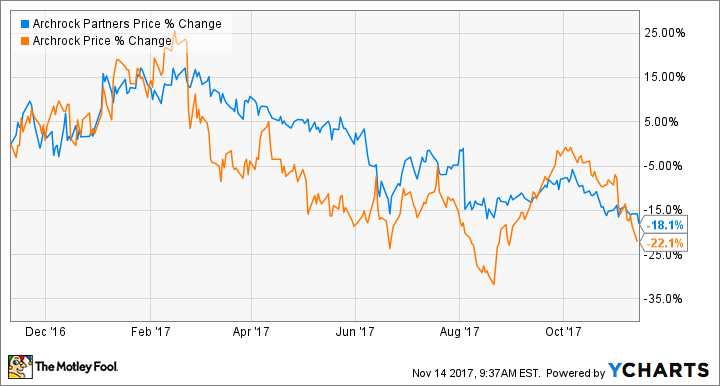Based on Archrock Partners' (NASDAQ: APLP) current distribution yield of 8.7%, it's safe to assume that Wall Street doesn't think much of this stock. Its last quarterly report didn't offer the market convincing enough reasons to change that sentiment, but there were sufficient positive signs in the results to think that there is value in the shares of the No. 1 U.S. provider of natural gas compression services.
Here's a rundown of the company's results, why management thinks last quarter was a bit of an aberration, and why Archrock Partners may be a stock worth following.

Image source: Getty Images.
By the numbers
| Metric | Q3 2017 | Q2 2017 | Q3 2016 |
| Revenue | $140.2 million | $138.2 million | $135.5 million |
| Adjusted EBITDA | $59.9 million | $66.9 million | $67.9 million |
| Net income per share | ($0.06) | $0.08 | ($0.01) |
| Distributable cash flow | $29.8 million |
$39.1 million |
$43.7 million |
Source: Archrock Partners earnings release.
Here's the good news about this past quarter: Archrock is starting to see the benefits of a secular increase in natural gas compression demand. Even though the revenue increase was modest, the company had the most new orders in its short history. Archrock Partners and its parent company Archrock (AROC 1.95%) deployed 50,000 more horsepower this past quarter.
The reason it hasn't translated to higher EBITDA or cash flow yetis because of higher activation costs. Gross margins slipped from 61% in the prior quarter to 55% this past one. This margin contraction also led to lower bottom line and distributable cash flow results. Even though distributable cash flow declined again, Archrock Partners' distribution coverage ratio was 1.46 times, which is more than enough to cover its payout.
At the beginning of the year, management's priority was to lower the company's leverage ratio to 3.5 times. The declines in revenue and EBITDA over the past several quarters have made that goal almost impossible to achieve. At the end of Q3, Archrock Partners had a debt-to-EBITDA ratio of 6.2 times.
What management had to say
Even though Archrock Partners' results continue to decline, CEO Brad Childers' was surprisingly upbeat. According to his statement, Q3 was a turning point for the company's business, and we should expect things to get better in Q4:
Archrock Partners' operating horsepower growth accelerated in the third quarter. During the quarter, we grew operating horsepower by 50,000 horsepower and drove new orders at the highest quarterly rate on record. Demand for our services has remained elevated, setting the foundation for a strong 2018. Additionally, we strengthened our capital position with the completion of a $60 million equity offering during the third quarter.
As we have stated, we expect gross margin percentage volatility during this phase of the growth cycle. Although gross margin percentage declined in the third quarter, we expect sequential gross margin percentage improvement in the fourth quarter. Increased lube oil expense, higher expenses due to elevated start activities, and higher medical claims contributed to higher costs in the third quarter.
What a Fool believes
As much as you may want to give Archrock a hard time for posting another loss this quarter, at least the company's decline was for the right reasons. We saw land rig owners and oil services companies go through the same thing a couple of quarters ago as demand was increasing at a blistering pace and companies were paying through the nose to reactivate idle equipment. Since Archrock's business is a post-production service, it's not too surprising to see demand increases lag other oil services sub-sectors.
The recoveries of Archrock and Archrock Partners have been agonizingly slow, but they are on the upswing. Natural gas demand is higher in the winter months, and the next few years will bring a colossal increase in annual demand from exports via pipeline and LNG. As this takes trend progresses, Archrock should be able to put a greater percentage of its compression horsepower into the field as well as grow the business. With an already sky-high distribution yield that is well covered by current cash flow, this stock is looking more attractive.





